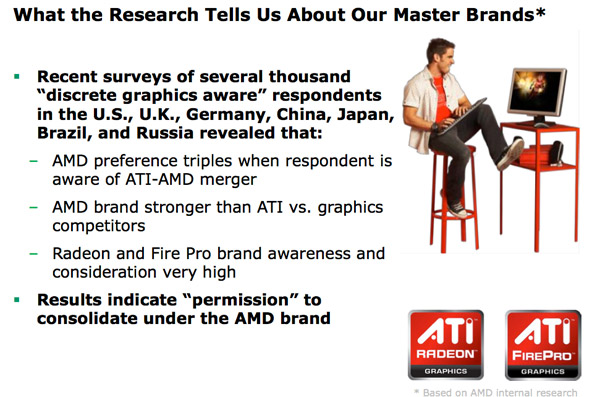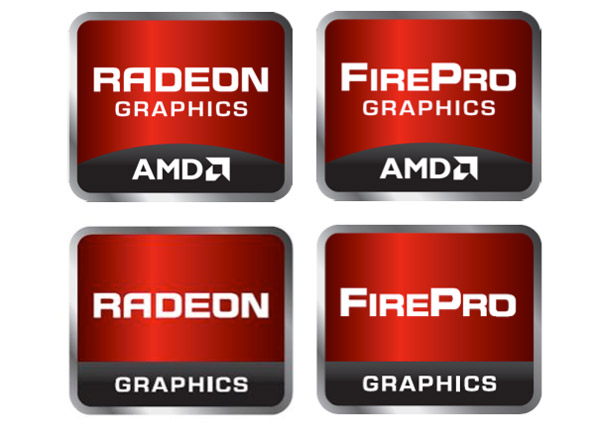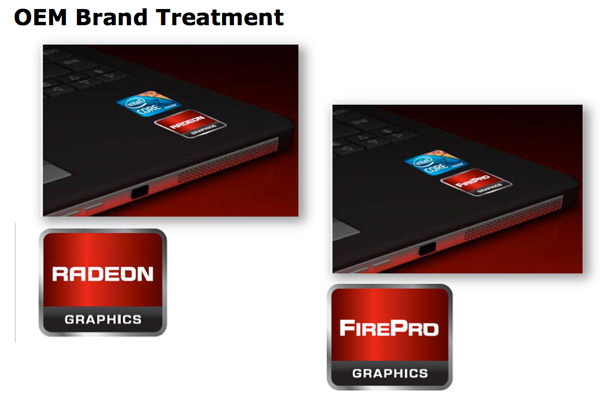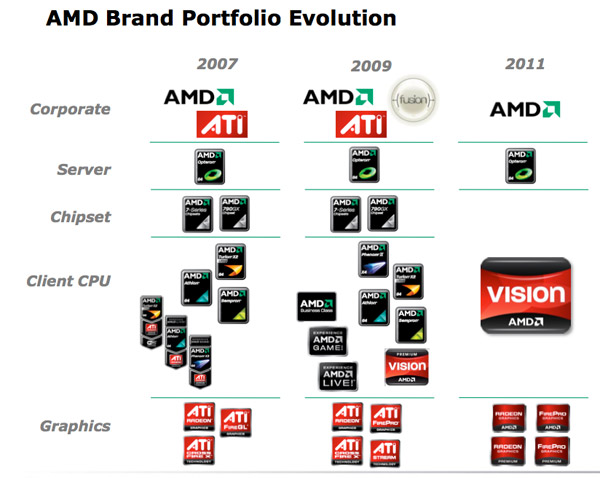Farewell to ATI, AMD to Retire the ATI Brand Later this Year
by Anand Lal Shimpi on August 30, 2010 12:02 AM ESTFour years ago AMD did the unthinkable: it announced the 5.4 billion dollar acquisition of ATI in a combination of cash and stock. What followed was a handful of very difficult years for AMD, an upward swing for ATI and the eventual spinoff of AMD’s manufacturing facilities to GlobalFoundries in order to remain profitable and competitive.
In the years post acquisition, many criticized AMD for blowing a lot of money on ATI and having little to show for it. Even I felt that for $5.4 billion AMD could’ve put together its own competent graphics and chipset teams.
Despite the protest and sideline evaluations, good has come from the acquisition. The most noticeable is the fact that AMD’s chipset business is the strongest it has ever been. AMD branded chipsets and integrated graphics are actually very good. And later this year, AMD will ship its first Fusion APUs (single die CPU/GPU): Ontario using Bobcat cores and an AMD GPU. Ontario will be the first tangible example of direct AMD/ATI collaboration since the acquisition.
Just as we’re about to see results from the acquisition AMD is announcing that it will retire the ATI brand later this year. Save those boxes guys, soon you won’t see an ATI logo on any product sold in the market.

The motivation behind the decision to retire the ATI brand comes from AMD’s own internal research. Unfortunately AMD isn’t sharing the details of this research, just the three major findings from it:
1) AMD brand preference triples when the person surveyed is aware of the ATI-AMD merger.
2) The AMD brand is viewed as stronger than ATI when compared to graphics competitors (presumably NVIDIA).
3) The Radeon and Fire Pro brands themselves (without ATI being attached to them) are very high as is.
The second point is really the justification for all of this. If AMD’s internal research is to be believed, AMD vs. NVIDIA is better from a marketing standpoint than ATI vs. NVIDIA. Honestly, AMD’s research seems believable. AMD has always seemed like a stronger brand to me than ATI. There’s little room for ego in business (despite it being flexed all too often) and I don’t believe AMD would hurt its marketing simply to satisfy any AMD executives - the research makes sense.
Meanwhile the third point is the realization that there are very few product lines with the ATI brand left. ATI's chipset operations were quickly absorbed in to AMD and given appropriate naming, while ATI's consumer electronics products such as their Digital TV division have been sold to other companies. Radeon and FirePro are the only two ATI product lines left, and both are strong brands on their own.
The brand switch also reflects some internal changes at AMD. Many important ATI employees have been relocated to AMD's base of operations in Austin, Texas in order to help with Liano, Ontario, and AMD's future Fusion products. So the line between AMD and ATI has been further blurring for some time.
The brand switch will start late this year, I’d guess in Q4 with Ontario and a new GPU release. AMD (and NVIDIA) originally had GPU designs for the 32nm process node however extensive teething problems with 40nm and 32nm forced TSMC to cancel the node and move directly to 28nm. This cancellation required both companies to redesign their parts to work within existing 40nm processes and move their original plans out to coincide with 28nm in 2011. As a result we will see an incremental update to the Radeon HD 5000 series at the end of this year, but don’t expect the sort of performance boost we got with the 5800 vs. 4800. This upcoming hardware will probably carry the AMD Radeon HD 6000 series brand. All existing hardware will continue to carry the ATI brand.
To go along with the new brand we get new logos. If OEMs want to display a badge without the AMD brand, there’s an alternative for that as well:

AMD states the AMD-less logos are purely at the request of OEMs who sell systems with Intel CPUs and AMD GPUs. I suspect Intel’s logo program may have some stipulations on being used adjacent to a sticker with an AMD logo on it, although AMD told me it was purely at the request of the OEMs trying to avoid confusion.

The other major change is AMD’s brand simplification at the retail level. Last year AMD introduced a new platform brand called Vision. If you buy a PC with all AMD components (CPU, chipset and GPU) it can carry a Vision logo (similar to Intel’s Centrino brand). There are four categories of Vision support all with increasing hardware requirements: Vision, Vision Premium, Vision Ultimate and Vision Black. The idea is that if you buy a standard Vision PC you’ll have a good entry level machine, but buying up the stack grants you additional capabilities and performance (e.g. Blu-ray playback, web cam support, discrete GPUs, multicore CPUs etc...). We’ve explained it all in greater detail here.
Starting next year, AMD’s Vision badge will be the only CPU brand you see on retail desktops/notebooks. You’ll still get Radeon/Fire Pro badges on systems that use those parts, but you’ll no longer see a Phenom II, Athlon II, Turion or Sempron logo on Vision systems. Instead you’ll see what CPU is inside on the little card that sits next to the system at your local retailer.

I suspect this will last until AMD introduces Bulldozer, at which point it’ll probably be very eager to build up its brand - assuming performance its is competitive.
Final Words
Retiring the ATI brand comes at an interesting time in the microprocessor market. Graphics is becoming much more important, but to date we have very few examples outside of 3D games as good consumer applications for powerful GPUs. AMD views this as the perfect time to consolidate its brands before the CPU/GPU line gets more blurry.

AMD also pointed out that its market share has been on a steady climb over the past few years. According to Mercury Research, AMD’s discrete GPUs climbed from ~33% marketshare at the end of 2007 to 51% last quarter. AMD has executed unusually well on the GPU side and NVIDIA has had some very difficult years in the process, both of which are responsible for AMD’s climb. The ATI name will go out on a high note.

AMD Discrete GPU Marketshare, Source: Mercury Research
If all goes well with AMD’s two exciting new CPU architectures next year, the brand will only get stronger going forward. Bobcat could do very well in today’s netbook/thin and light notebook form factors and Bulldozer may mark a return to competition in the server and high end desktop markets.










80 Comments
View All Comments
5150Joker - Sunday, August 29, 2010 - link
First there was 3dfx and now the ATi brand will be gone. It makes sense from a marketing point of view and AMD's reasons seem valid enough. However, as one of those gamers that grew up with ATi/nVidia/S3/Matrox/3dfx etc. it's a bit sad to see such an established brand removed from the market for good.PresupuestosPC - Monday, August 30, 2010 - link
True story! Oh, boy, good times! Don't forget Number Nine, Trident, Rendition, 3DLabs, Real3D or PowerVR (I know they still exist doing mobile chips and such). Even SiS built GPUs back then!!Sad day to us PC enthusiasts.
RIP ATI (brand).
dingetje - Monday, August 30, 2010 - link
anyone remember tseng labs (et4000)?whatever happened to hercules?
good times...
Belard - Monday, August 30, 2010 - link
et4000...Man YOU are OLD...! But yeah, remember when ET4000 was considered a kick-ass card, by PC standards.
BUT there is a difference of ATI vs. many of the others...
ATI is bought out and its technology, people and support continue. I'll miss the ATI logo... hey, nowadays it was getting a bit odd for branding to have two company colors with two 3-letter name products. So we have RED-AMD for Graphics and Green AMD for everything else. ;)
3Dfx self-destructed when they went into business for themselves. Nvidia concentrated on getting out GPUs every 6 months and 3Dfx bought STB (which was local and I had friends that worked for them) - funny thing, STB had just released and then phased out an excellent TNT card when the buy-out happened ;) The Voodoo 5/6 was a failure. To big, to hot, to expensive. Voodoo 3/4 had the issues of NO 24bit color which was showing in some games. If you look, you'd see Voodoo5 6000 cards with 4 (FOUR) GPUs on a single card! Look it up, its huge and had an external power supply. You could say, 3Dfx lives in Quantum3D which is still in business today - selling Military grade 3D Graphics systems.
Many of the old brands like Diamond, Hercules, etc depended on getting their GPUs (not much we'd consider GPUs by todays standards) from many sources. ATI was the only company that made their Chips and cards. It was when AMD bought out ATI and allowed other companies to sell ATI products that ALLOWED ATI to grow market share (hint hint Apple)
S3 Lives... in making junk expensive graphic cards that barely work. (Chrome)
Trident, just a name...
pukemon - Monday, August 30, 2010 - link
Actually before AMD bought them in 2006 you could already buy "Powered by ATI" cards vs "Built by ATI" cards.Samus - Monday, August 30, 2010 - link
I had an ET4000 in my Compaq Prolinea 4/25s, upgraded with a 486DX4-75 overdrive, overclocked via 25/33mhz bus selector to 100MHz. Unfortunately the lack of a PCI bus slot stuck me with that video chip for some time. It was just fine for Warcraft II and Doom II Deathmatch but when Quake rolled around with 3DFX support, the lack of VLB or PCI expansion forced me to dump the computer for my first home-built system: An AMD K5-75MHz overclocked to 120MHz.dingetje - Tuesday, August 31, 2010 - link
heheheI remember my first pc's....with 8088 cpu (also 8086 and 8086-2)
Of course that's all PRE 286, 386, 486 (anyone remember those cheap cyrix cpu's?)
The screens (mid eighties) were amber or green monochrome bulbs driven by "hercules" cards.
Somewhat later we got cga, then ega and finally vga (256 colors !!)) which really made "pc gaming" look awesome compared to 2 colors (B & W).
And let's not go into the storage technology we had :/ omg
Somehow the magic of those days is gone, but I'll gladly trade the magic for the kickass hardware we have now :P
Edison5do - Monday, August 30, 2010 - link
Lets pray that dont happen... And as my self.... people use to love the ATI brand.. (in my old G3 Imac) good times... i have been tracking the ATI since early 2000´s and I could say for me... I have always seen ATI like better quality than AMD brand....... since they merge with ATI they have been 5 years Strugglin and now after 5 years they will make the fist CPU (wich its supposed to be their main concern) that "will" compete to Intel´s technology.And all this time everybody have always seen ATI up high and AMD dont enjoy the same in lots of people minds.
johnsonx - Monday, August 30, 2010 - link
I had a tseng labs ET4000 ISA-16 card. Also an ATI Mach32 EISA card.johnsonx - Monday, August 30, 2010 - link
in fact, I'm pretty sure I still have the Mach32 in a box somewhere (a cardboard box that is, not a PC... I doubt I have an EISA mainboard anywhere).